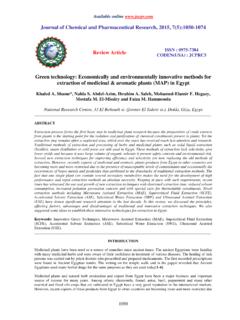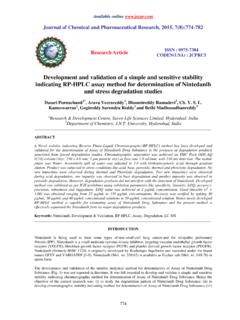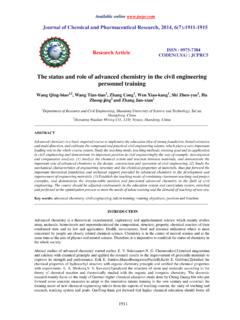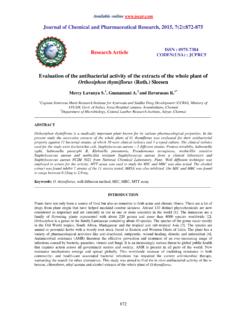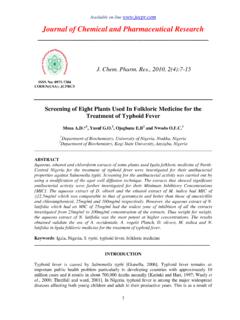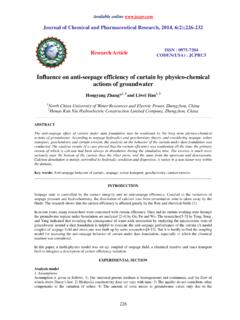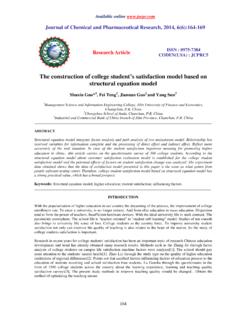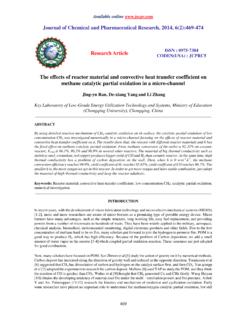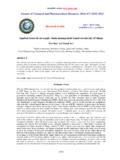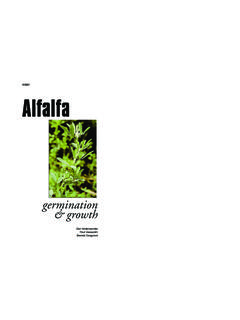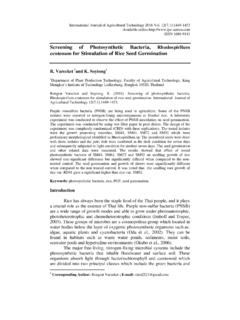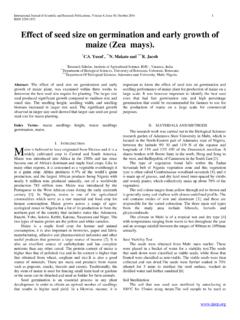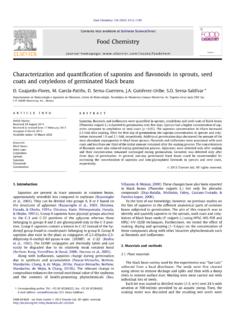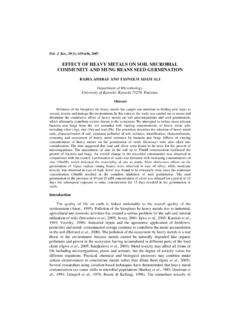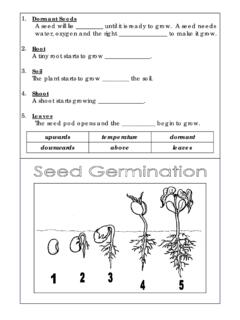Transcription of Research Article ISSN : 0975-7384 CODEN(USA) : …
1 Available online Journal of Chemical and Pharmaceutical Research , 2016, 8(1):403-410 Research Article issn : 0975 - 7384 coden (USA) : JCPRC5 403 Seed germination and anthelmintic activity of Cajanus cajan on sheep Kabore Adama1*, Konate Almamy1, Gnanda B. Isidore1, Yougbare Bernadette1, Traore Amadou1, Teguera Abdoul Aziz2, Diarra Siaka3, Tamboura H. Hamidou1 and Belem A. M. Gaston4 1D partement Productions Animales / Institut de l Environnement et de Recherches Agricoles, Ouagadougou, Burkina Faso 2 Minist re des Ressources Animales et Halieutiques, Ouagadougou, Burkina Faso 3 Institut Polytechnique Rural de Formation et de Recherche Appliqu e (IPR/IFRA) de Katibougou /Annexe de Bamako, Bamako, R publique du Mali 4 Institut du D veloppement Rural / Universit Polytechnique de Bobo-Dioulasso, Ouagadougou, Burkina Faso _____ ABSTRACT Nematodes parasites of gastrointestinal tract are a major constraint of small ruminant raising in rural farm of Burkina Faso.
2 In the search of endogenous alternatives solutions, this study was initiated to evaluate the potential anthelmintic activity of Cajanus cajan fodder plant in sheep. For this purpose, seed germination test was carried out to produce C. cajan fodder which was used to evaluate adult motility test in vitro and faecal egg counts reduction test in vivo in natural infestation condition. For the first test, applied pretreatments (mechanical scarification and immersion in water for 24 hours) significantly increased the speed of seed germination until the second day after seeding compared to the control (untreated). The results of in vitro anthelmintic activity of C. cajan aqueous extract revealed that the tested concentrations (100, 50 and 25 mg / ml) inhibited H. contortus adult worms during the test. In vivo anthelmintic results of C. cajan fodder administered at 3 g / kg body weight to the animals of treated group (n = 6) showed a decrease in egg excretion (P>0,05), a weight increase and a larger hematocrit levels (P> ) compared to control group (n = 6).
3 These results show that the use of C. cajan fodder is beneficial to small ruminants in infested area of gastrointestinal parasites. Therefore, it could be popularized in north Sudanese area of the country in an integrated struggle approach to improve animal and agricultural production. Keywords: Germination; Gastrointestinal parasites; sheep; Cajanus cajan; Burkina Faso, Anthelmintic activity _____ INTRODUCTION In Burkina Faso, national herd of small ruminants is numerically significant and estimated strengths are 8 243 238 sheep and 12 342 454 goats [1]. Unfortunately, their livestock productions are low related to misconduct and poor health situation of animals like in African subtropic areas [2]. Indeed, practiced raising mode focuses mainly on the exploitation of natural pastures and having direct consequence gastrointestinal parasites that are the cause of digestive pathologies, major constraint of small ruminants in the tropics [3].
4 Various parasites are responsible for these digestive diseases and Haemonchus contortus is among the most dominant in Burkina Faso. This parasite induces enormous socio-economic losses to rural low-income family farmers and small ruminants for which prominently at their farms [4]. Facing the high costs of conventional products and the lack of veterinary officials in some parts of the country, alternative solutions based on the use of medicinal plants have been explored by rural Kabore Adama et al J. Chem. Pharm. Res., 2016, 8(1):403-410 _____ 404 farmers to control gastrointestinal parasites [5]. In the current context of the country, the legume shrub Cajanus cajan is greatly exploited by small rural producers for multiple therapeutic activities [6]. Also, this study was initiated to evaluate the potential anthelmintic activities of the plant fodder to improve the health and nutrition of small ruminants.
5 Pursued objectives through the study were (i) to determine the best pretreatment for good seed germination to produce C. cajan fodder and (ii) to verify the anthelmintic activity of C. cajan fodder through in vitro and in vivo tests on gastrointestinal parasites of small ruminants. MATERIALS AND METHODS 1- Study site This study was conducted to Saria Experimental Station of the Institute of Environment and Agricultural Research (INERA). This station is located at 12 16' north latitude and 2 09' west longitude and covers an area of 400 hectares. The climate regime is north Sudan type characterized by a short rainy season (June to September) and a long dry season (October to May), which are subject to strong irregularities linked to fluctuations in atmospheric parameters. Temperatures are generally high during the year but with a moderation during rainy season (25-35 C) where the relative humidity are between 60-70%.
6 Soils are tropical ferruginous leached type, very deficient in phosphorus and low in organic matter and shallow [7]. The vegetation is characterized by the presence of a savannah annual grass, trees and shrubs. 2- Materials Vegetal material C. cajan seeds and leaves were used to conduct experimental tests. C. cajan seeds were harvested during the dry season of 2010-2011 at the Experimental Station Saria. They were kept in a plastic bag placed in the natural conditions. Meanwhile, a sample of plant forage was collected and washed with water before being dried in dust-free. Then the dried sample was ground to a fine powder to produce a decoction using 100 g powder and diluted in 1 000 ml of distilled water at boiling temperature for 1 hour. Decoction obtained was cooled before being filtered through cotton wool first and then filtered on paper. Resulting aqueous extract was lyophilized after and stored for bioassay in vitro.
7 Also, a stock of C. cajan fodder was constituted from a parcel sowed of the plant seeds for in vivo test during the 2011-2012 winter season. Animal material Haemonchus contortus adult worms have been used for in vitro test and Mossi breed sheep for in vivo test. H. contortus adult worms were obtained from the stomachs of sheep naturally infected. For this, stomachs were purchased for slaughter of Koudougou and transported to Saria Experimental Station to undergo a longitudinal incision. Adult worms were carefully collected manually using forceps and placed in a polypropylene bottle with closure and containing PBS. Used sheep had a mean weight of kg and came from the fold of the Department of Animal Production Saria Station. In winter, the food needs of animals are covered by exploitation of natural pastures. 3- Applied methods Three experiments were conducted, namely a germination test and anthelmintic activity of fodder plant through in vitro and in vivo tests.
8 Experiment 1: Germination test Germination study was performed with intact seeds (free from the pericarp). To this end, three groups were constituted and composed of treated and untreated groups. Treated groups consisted of one group which intact seeds were soaked for 24 h in water and another group whose seeds have been mechanically scarification. Scarification was done by making a small nick in the seed coat on the side opposite pole micropilaire respecting the integrity of the kernel using a razor blade. Seedlings were carried out in Petri dishes filled with a double layer of filter paper moistened to saturation. Three repetitions of 15 seeds were established for each group. Counting of germinated seeds was performed daily and cumulative germination percentages were determined daily to the in ambient temperature of laboratory. A seed was considered germinated when the radicle becomes visible [8].
9 The germination percentage was calculated according the following formula: Kabore Adama et al J. Chem. Pharm. Res., 2016, 8(1):403-410 _____ 405 Germination percentage = (number of sprouts / total number of seeds placed in the Petri dish) x 100 Experiment 2: In vitro Test Living adult worms of H. contortus of small ruminant naturally infected were used to perform in vitro test. The technique described by Sharma et al. [9] was used with modifications [10]. Briefly, adult worms of H. contortus were collected from stomachs of small ruminants freshly slaughtered at the abattoir of Koudougou and cleaned before put in a Petri dish containing PBS. After, three (3) adults worms were exposed to each well of a 24 well plate (Becton Dickinson brand) for the treatments at ambient temperature of laboratory (25-30 C). The treatments consisted of three increasing concentrations (25, 50 and 100 mg / ml) of the aqueous extract of C.
10 Cajan and an untreated group using distiller water. Each treatment was repeated three times. Inhibition of motility adult worms was used as the criterion of anthelmintic activity for each of the above treatments. Motility was observed at intervals of 0, 2, 4 and 6 hours. At the end of the test, the treated worms were put in distiller water for 30 min to observe the recovery of motility worms. Experiment 3: In vivo test In vivo study was conducted in natural infestation condition from September to October 2012 on sheep supplemented with C. cajan fodder. For this, two groups of six sheep were used. Group 1 was supplemented with C. cajan fodder at 3 g / kg body weight of animal and group 2 served as a control (not supplemented). Following parameters were measured in sheep after treatment application: - fecal egg count reduction at days 0, 7, 14 and 21. To this end, a quantitative coproscopy was made in two animal groups before treatment (day 0) and after treatment (days 0, 7, 14 and 21).
